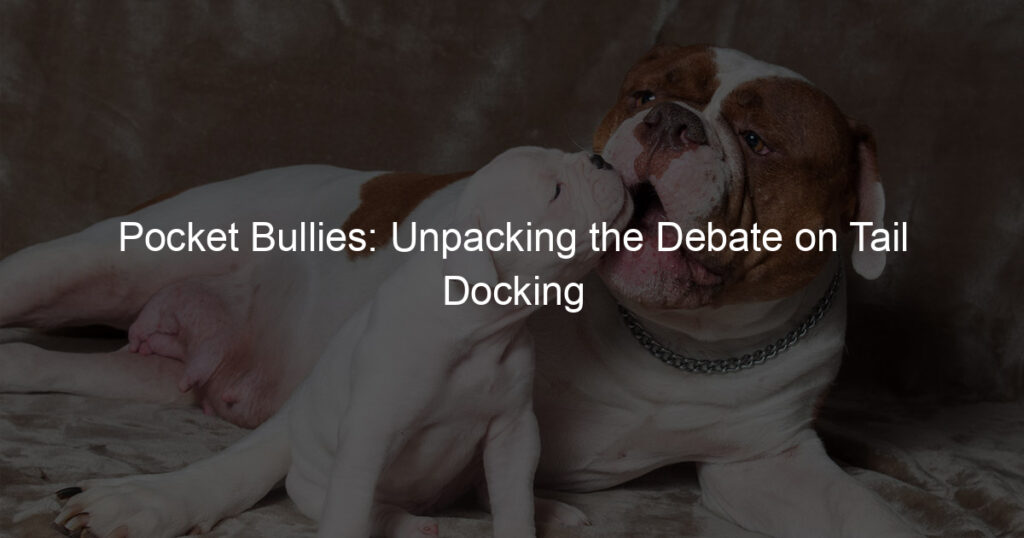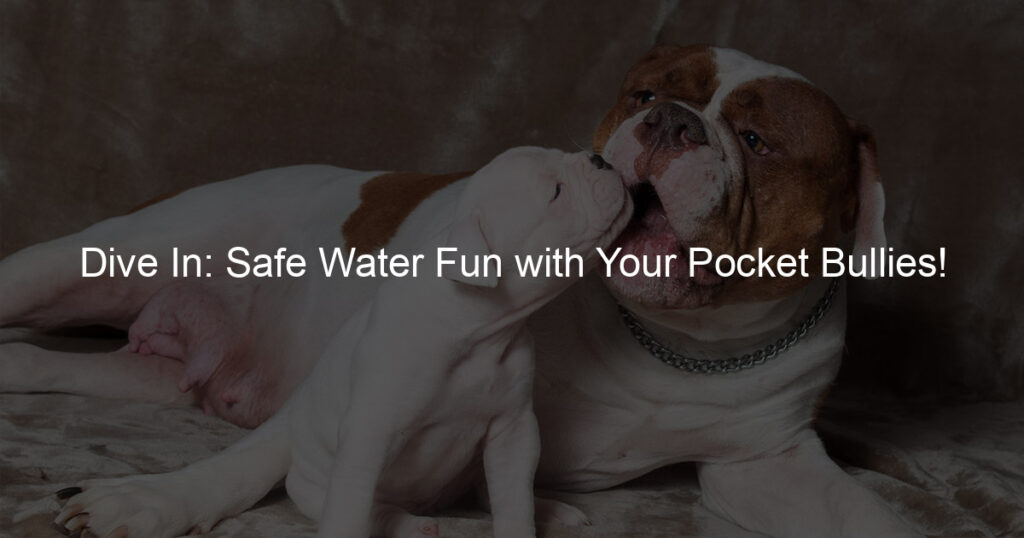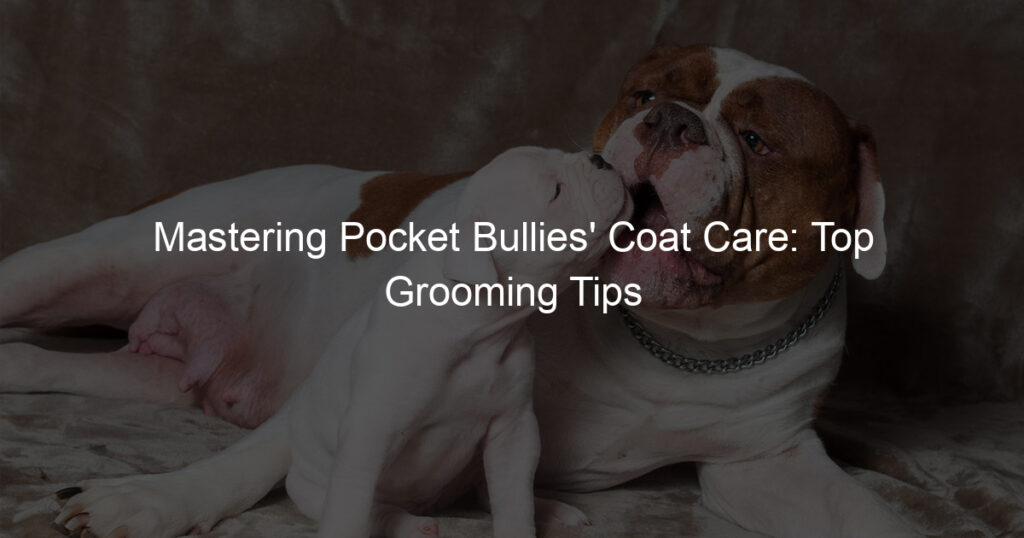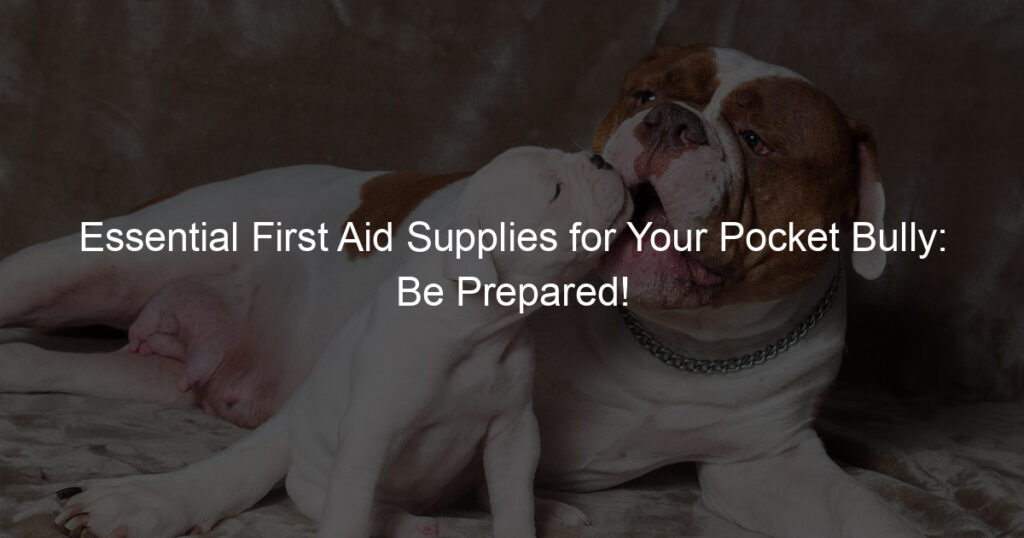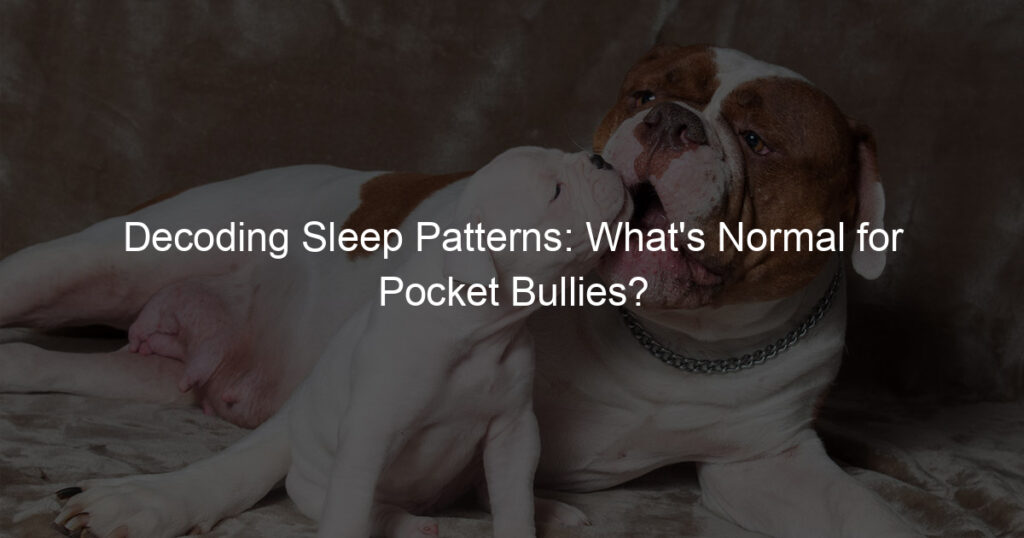
Introduction to Pocket Bullies and Tail Docking
Welcome to our comprehensive guide on Pocket Bullies and tail docking. This post is designed to provide clear and informative content about these topics. Let’s dive in.
- Overview of the Pocket Bullies breed
- Explanation of tail docking
- Why tail docking is a topic of debate
The Pocket Bully is a smaller type of the American Bully. Despite their intimidating name, they are known for their friendly and affectionate nature. They are compact, muscular dogs with a smooth coat, blocky head, and a short stature. Their height ranges from 12 to 16 inches, making them the perfect size for those who prefer smaller dogs with a robust physique.
Tail docking is a procedure often performed on puppies within a few days of their birth. It involves the removal of most of the tail. This procedure is usually done without anesthesia, and it’s a practice that has been around for centuries. Initially, tail docking was done for practical reasons like preventing tail injuries for working dogs. However, these days, it’s often done for cosmetic reasons to maintain a breed’s specific look.
Tail docking is a controversial topic among animal rights activists, veterinarians, and dog breeders. The main point of contention is whether the cosmetic appeal justifies the potential pain and risks associated with the procedure. Some argue that it’s a harmless tradition that maintains the breed’s look, while others believe it’s an unnecessary practice that causes pain and can lead to health complications.
In the following sections, we will delve deeper into the considerations for tail docking in Pocket Bullies, the tail docking process, how it compares to other small breeds, and case studies. We will conclude with a balanced view on the pros and cons of tail docking in Pocket Bullies.
Considerations for Tail Docking in Pocket Bullies
When it comes to tail docking in Pocket Bullies, there are several factors to consider. One of the most important aspects is the medical implications of this procedure. Let’s explore this in more detail.
Medical Considerations
From a medical perspective, tail docking can have both benefits and potential risks for Pocket Bullies. It’s crucial to understand these aspects before making a decision.
- Health benefits of tail docking
- Potential health risks and complications
Some argue that tail docking can prevent future injuries for Pocket Bullies. For instance, in high-energy breeds like these, tails can sometimes get caught or injured during play. Docking might reduce such risks. Moreover, it may prevent tail-related health issues such as ‘happy tail syndrome’, where dogs injure their tails from excessive wagging against hard surfaces.
On the other hand, tail docking is not without its potential health risks. The procedure, if not performed correctly, can lead to complications like infection or nerve damage. Additionally, the tail plays a significant role in a dog’s balance. Removing it might affect a Pocket Bully’s agility and movement. Lastly, like any surgical procedure, tail docking involves a certain level of pain and discomfort for the dog.
In conclusion, while there are potential health benefits to tail docking, it’s important to weigh these against the possible risks and complications. Always consult with a professional veterinarian to understand the best course of action for your Pocket Bully.
Behavioral Considerations
When considering tail docking in Pocket Bullies, it’s crucial to understand the potential behavioral impacts. This procedure can significantly influence a dog’s behavior and its ability to communicate with other dogs.
- Impact of tail docking on Pocket Bullies’ behavior
- How tail docking can affect communication with other dogs
Tail docking can have a profound effect on a Pocket Bully’s behavior. The tail is an essential part of a dog’s balance system. When a dog’s tail is docked, it may experience difficulties in maintaining balance during high-speed activities or sharp turns. This can lead to a decrease in physical activity and a change in behavior.
Furthermore, some studies suggest that tail docking can lead to increased aggression. Without their tails, dogs may feel more vulnerable and resort to aggressive behavior as a defense mechanism. However, it’s important to note that this is not a guaranteed outcome and can vary greatly between individual dogs.
Dogs use their tails as a significant form of communication with other dogs. A wagging tail can indicate happiness, while a stiff, upright tail can signal alertness or aggression. By docking a dog’s tail, we may inadvertently impair their ability to communicate effectively.
Without a tail, a dog may struggle to convey its emotions and intentions to other dogs. This can lead to misunderstandings and potential conflicts. It’s important for dog owners to be aware of this potential issue and take steps to mitigate any communication difficulties.
In conclusion, while tail docking in Pocket Bullies can have potential benefits, it’s essential to consider the potential behavioral impacts. Each dog is unique, and what works for one may not work for another. It’s always best to consult with a professional before making any decisions about tail docking.
Ethical Considerations
- Arguments for Tail Docking in Pocket Bullies
Some people argue that tail docking in Pocket Bullies is a tradition or a breed standard. They believe that it gives the dogs a certain look that is desirable in the show ring. Others argue that tail docking can prevent future injuries. For instance, a Pocket Bully with a docked tail is less likely to suffer from tail injuries while playing or running around.
- Arguments Against Tail Docking in Pocket Bullies
On the other hand, there are those who argue that tail docking is unnecessary and cruel. They believe that it causes unnecessary pain and stress to the dog. Some also argue that a dog’s tail is an important tool for communication. Without it, a dog may have difficulty expressing its feelings and intentions to other dogs and to humans. Moreover, the American Veterinary Medical Association (AVMA) opposes tail docking when done for purely cosmetic reasons.
- Legal Status of Tail Docking in Different Regions
The legal status of tail docking varies greatly from one region to another. In some countries, like the United Kingdom and Australia, tail docking is banned except for certain working breeds. In the United States, tail docking is legal, but some states have restrictions or requirements. For instance, in New York and Vermont, tail docking must be performed by a licensed veterinarian. It’s important for Pocket Bully owners to be aware of the laws in their region before deciding to dock their dog’s tail.
The Tail Docking Process for Pocket Bullies
Understanding the tail docking process for Pocket Bullies is crucial for any potential owner or breeder. This procedure, while common, involves several steps and requires careful attention to ensure the health and well-being of the dog.
- When tail docking is typically performed
- How the procedure is carried out
- Post-operative care and potential complications
Tail docking is typically performed when the Pocket Bullies are between 2 to 5 days old. At this age, the puppies’ bones are still soft, and the procedure is less painful. It’s important to note that tail docking should always be performed by a qualified veterinarian to minimize any potential risks.
The tail docking procedure begins with the veterinarian applying a local anesthetic to numb the area. The vet then uses a special pair of scissors to cut off the majority of the tail. The remaining stub is usually about an inch long. After the tail has been cut, the vet will stitch the area and apply an antiseptic to prevent infection.
After the procedure, it’s crucial to monitor the puppy closely for any signs of discomfort or infection. The tail area should be kept clean and dry to promote healing. If you notice any redness, swelling, or discharge, it’s essential to contact your vet immediately. While complications are rare, they can include infection, bleeding, and nerve damage.
In conclusion, tail docking is a common procedure for Pocket Bullies, but it’s not without its risks. It’s crucial to understand the process and potential complications before deciding to dock your puppy’s tail. Always consult with a qualified veterinarian to ensure the best possible care for your pet.
Tail Docking in Other Small Breeds
While we have been focusing on tail docking in Pocket Bullies, it’s important to note that this practice is not exclusive to this breed. Other small breeds also undergo tail docking for various reasons. Let’s take a closer look at how tail docking practices compare across different breeds and the reasons behind these practices.
- Comparison of tail docking practices in Pocket Bullies and other small breeds
- Reasons for tail docking in different breeds
Just like Pocket Bullies, many other small breeds such as Yorkshire Terriers, Rottweilers, and Boxers also have their tails docked. However, the reasons and methods may vary. For instance, in Pocket Bullies, tail docking is often done for aesthetic reasons and to maintain breed standards. On the other hand, in breeds like Rottweilers and Boxers, tail docking is traditionally done to prevent injuries when the dogs are working.
As for the method, most breeders use a similar process for tail docking across different breeds. This typically involves cutting off the tail of a puppy a few days after birth, often without anesthesia. However, the exact length of the tail left varies among breeds. For example, Pocket Bullies usually have their tails docked very short, almost to the base, while other breeds may have a longer stub left.
As mentioned earlier, the reasons for tail docking can vary greatly among different breeds. In some breeds, tail docking is done for practical reasons. For example, in hunting or working dogs, a long tail can be a liability that gets in the way or gets injured.
In other breeds, tail docking is more about aesthetics. Some breeders believe that certain breeds look better or more ‘correct’ with a docked tail. This is often the case for breeds like the Pocket Bully or Doberman Pinscher.
However, it’s important to note that tail docking is a controversial practice. While some people believe it’s necessary for certain breeds, others argue that it’s an unnecessary and cruel procedure. As a responsible pet owner, it’s important to understand the reasons behind tail docking and make an informed decision about whether or not to dock your dog’s tail.
Case Studies: Tail Docking in Pocket Bullies
Let’s take a closer look at some real-life examples of Pocket Bullies that have undergone tail docking. These case studies will help us understand the long-term effects and observations associated with this procedure.
- Examples of Pocket Bullies that have undergone tail docking
- Long-term effects and observations
Meet Bella and Max, two Pocket Bullies who had their tails docked when they were puppies. Bella’s owner decided to dock her tail for aesthetic reasons, while Max’s tail was docked due to a medical condition.
Bella is now a healthy, active adult dog. She has no issues with balance or mobility, which are common concerns about tail docking. Max, on the other hand, had some initial discomfort after the procedure but has since recovered fully.
Both Bella and Max have adapted well to life without a tail. However, it’s worth noting that every dog is unique. Some dogs may experience long-term effects such as pain, discomfort, or behavioral changes after tail docking.
It’s also important to remember that tail docking is a surgical procedure. Like any surgery, it carries risks. Bella and Max were lucky to have experienced minimal complications, but not all dogs are so fortunate.
In conclusion, tail docking in Pocket Bullies can have varied outcomes. It’s crucial for pet owners to make informed decisions, considering both the potential benefits and risks. Always consult with a trusted veterinarian before making such a significant decision for your pet.
Conclusion: The Pros and Cons of Tail Docking in Pocket Bullies
In this final section, we will summarize the key points discussed throughout this article. We will also share some final thoughts on the ongoing debate about tail docking in Pocket Bullies.
- Summary of Key Points
Throughout this article, we have explored the topic of tail docking in Pocket Bullies in depth. Here are the main points we have covered:
- Introduction to Pocket Bullies and Tail Docking: We learned that Pocket Bullies are a popular breed of dog, and tail docking is a common practice that involves removing part of the dog’s tail.
- Considerations for Tail Docking in Pocket Bullies: We discussed various factors that owners should consider before deciding to dock their dog’s tail, such as the potential for pain and the impact on the dog’s communication.
- The Tail Docking Process for Pocket Bullies: We examined the process of tail docking, which usually takes place when the puppy is just a few days old.
- Tail Docking in Other Small Breeds: We compared tail docking practices in Pocket Bullies with those in other small breeds.
- Case Studies: Tail Docking in Pocket Bullies: We looked at several case studies that shed light on the real-world implications of tail docking.
- Final Thoughts on the Debate
The practice of tail docking in Pocket Bullies, as well as other breeds, is a topic of ongoing debate. On one hand, supporters argue that it can prevent future injuries and maintain breed standards. On the other hand, opponents believe it is unnecessary and can cause physical and emotional harm to the dog.
As a responsible pet owner, it’s crucial to weigh these pros and cons carefully. Remember, the wellbeing of your furry friend should always be your top priority. As we conclude, we hope this article has provided you with the information you need to make an informed decision about tail docking in Pocket Bullies.

